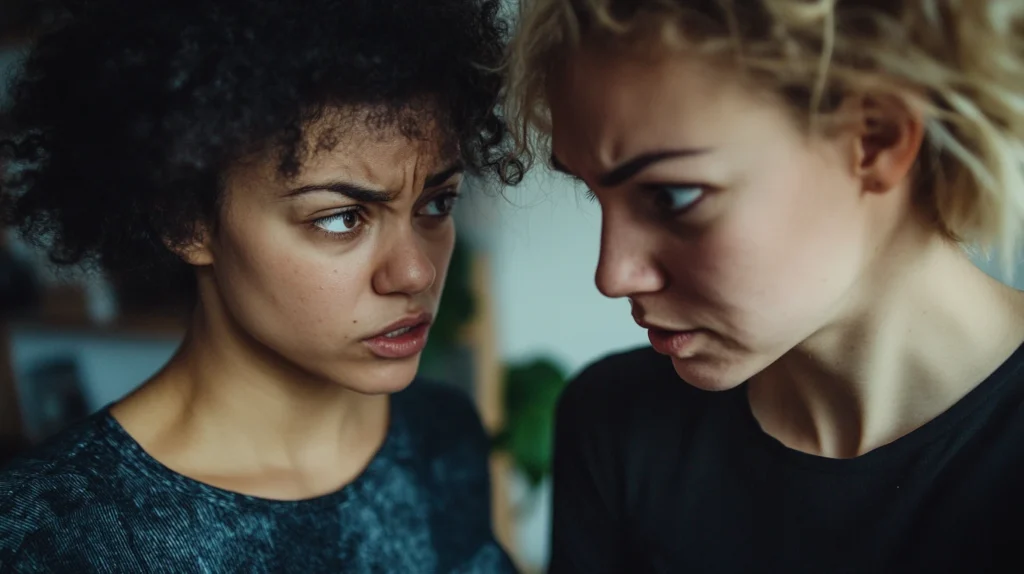Why do lesbian couples break up more often than heterosexual or even other queer relationships? The answer isn’t simple, but it’s certainly worth exploring. Studies and lived experiences point to a recurring trend: lesbian couples may split more frequently, and not necessarily because of incompatibility or lack of love.
This article digs deep into the emotional, psychological, and social factors behind this pattern. From intense emotional bonds and rapid commitment to communication breakdowns and external societal pressures, lesbian relationships navigate unique and often challenging dynamics.
We’ll explore the real causes behind these breakup trends, what typically goes wrong, and most importantly—how to build stronger, healthier, and more resilient lesbian partnerships that last.
Looking for inspiration? Try types of lesbian relationships to explore how different dynamics shape queer love.
Table of Contents
Common Triggers for Breakups in Lesbian Couples
Communication Overload and Overprocessing
Why do lesbian couples break up more often? One of the key reasons is communication overload. While open dialogue is vital in any relationship, lesbian couples often fall into a pattern of overprocessing—where every emotional nuance is dissected, discussed, and re-discussed.
This hyper-communication can lead to what psychologists call emotional flooding, where one or both partners feel overwhelmed and shut down. What starts as a desire to connect deeply ends up becoming exhausting and unsustainable. Instead of resolving issues, couples might find themselves trapped in circular conversations that fuel frustration rather than clarity.
In many cases, these communication patterns are driven by anxiety around conflict, which is more common in relationships between individuals with similar emotional styles. And because both partners may be emotionally attuned, it’s easy to slip into “mirror mode,” where neither can regulate the situation effectively.
Differences in Emotional Needs and Boundaries
Another trigger behind lesbian breakups is a mismatch in emotional expectations. Some partners may seek constant closeness and validation, while others value space and emotional independence. If not addressed early, these differences create resentment and a sense of emotional imbalance.
Why do lesbian couples break up more often when these needs clash? Because many partners skip the uncomfortable but necessary conversations about boundaries. In a rush to build emotional intimacy, some couples ignore signs of incompatibility—until those signs become dealbreakers.
Misunderstanding or ignoring personal boundaries can lead to co-dependency, one partner over-functioning emotionally while the other under-functions. This dynamic slowly erodes trust and connection, pushing both toward detachment or even passive withdrawal.
Discover great ideas like lesbian dating tips for beginners if you’re building a new connection and want to avoid common missteps.
Burnout, Identity Pressure, and Societal Stress

Emotional Fusion and Co-Dependency Burnout
Another reason why lesbian couples break up more often lies in the emotional burnout that stems from emotional fusion. When two people become emotionally enmeshed, the relationship can begin to feel more like a shared identity than a supportive partnership. In lesbian couples, where emotional mirroring is often high, the line between “me” and “us” can blur quickly.
This deep emotional merging may feel intimate at first, but over time it becomes suffocating. One or both partners may begin to lose their individual sense of self, leading to frustration, irritability, and eventually emotional detachment. When couples don’t set healthy emotional boundaries early, burnout becomes inevitable.
Emotional burnout often goes unspoken—partners don’t know how to express the fact that they feel “too close,” or they may feel guilty for needing space. Eventually, one might shut down emotionally or seek distance outside the relationship, causing a slow and painful breakdown.
External Pressures and Lack of Community Support
It’s not just what happens inside the relationship that leads to breakups—it’s also the social environment surrounding it. Many lesbian couples lack access to supportive queer communities, especially in areas where LGBTQ+ visibility is limited. Without that external validation, couples feel isolated, misunderstood, and sometimes invisible.
Additionally, some lesbian relationships face family rejection, microaggressions in public, or invalidation of their love compared to heterosexual norms. These external pressures place a heavy emotional load on the couple, creating a kind of “us against the world” mentality that can become toxic over time.
When the world constantly questions your relationship, you begin to internalize that doubt. It becomes harder to distinguish between what’s truly wrong in the relationship and what’s simply a reaction to societal stress.
Check out lesbian divorce rate to see how these pressures statistically impact long-term lesbian relationships.
Healing and Strengthening Lesbian Relationships

Building Healthier Emotional Space and Communication Habits
Understanding why lesbian couples break up more often is only part of the story—healing and rebuilding require action. One of the most effective ways to create lasting love is by learning to communicate clearly without emotional overload.
Lesbian partners often value vulnerability and openness, but communication must be constructive rather than excessive. Couples who practice intentional dialogue—listening without reacting, validating without absorbing—tend to navigate challenges better. Boundaries aren’t barriers; they’re lifelines.
Establishing emotional independence also helps both partners grow individually within the relationship. When each person has their own passions, goals, and space, the bond strengthens from a place of balance—not obligation or over-reliance.
Creating a rhythm of regular check-ins without turning every small issue into a full-blown conversation helps couples avoid burnout. Sometimes, it’s okay to say, “Let’s revisit this later,” rather than spiral into conflict.
Avoiding Common Pitfalls and Long-Term Tools
It’s crucial to recognize early red flags like emotional codependency, fast attachment without foundation, or avoidance of conflict. Lesbian couples thrive long-term when they embrace both emotional depth and emotional discipline.
Tools like couples therapy with an LGBTQ+ affirming counselor, relationship workshops, or even setting shared goals can bring clarity and alignment. Regular self-reflection—individually and together—also keeps emotions from building up unchecked.
Don’t miss our lesbian sexual health checklist, because emotional wellness often ties closely with physical intimacy in queer partnerships.
Couples who create a culture of support—not perfection—stand a stronger chance of overcoming the emotional challenges that often cause other relationships to falter.
FAQs
Why Do Lesbian Couples Break Up More Often?
Here are the most common questions people ask about lesbian relationships, breakups, and emotional challenges.
What are common reasons for breakups in lesbian relationships?
Common reasons include emotional intensity, fast-moving commitment, communication overload, and co-dependency. Many lesbian couples develop deep bonds quickly, which can lead to burnout if emotional boundaries aren’t maintained.
Is emotional intensity a factor in lesbian breakups?
Yes, emotional intensity is a major factor. Lesbian couples often build intimacy quickly and deeply, which can be beautiful—but also overwhelming if not balanced with independence and space.
Do lesbian couples move in together too quickly?
Often, yes. The so-called “U-Haul” stereotype reflects a real trend where lesbian couples cohabitate early. While it may feel right emotionally, it can put stress on the relationship before it’s ready.
How does communication affect lesbian relationship stability?
Healthy communication is essential, but overcommunication or constant emotional processing can cause fatigue. Lesbian couples need to find a balance between openness and emotional regulation.
Are lesbian relationships more prone to emotional burnout?
Yes. The combination of emotional merging, lack of boundaries, and external pressures can lead to burnout, where partners feel overwhelmed and emotionally drained.
Why do lesbian couples face unique relationship challenges?
They often face societal bias, lack of role models, family rejection, and community isolation. These external challenges amplify internal relationship stress.
Does lack of community support impact lesbian couples?
Absolutely. A lack of LGBTQ+ community access or visibility can leave couples feeling isolated, making it harder to feel validated and supported in their relationship journey.
Is the lesbian U-Haul stereotype real?
Yes—and no. It’s a stereotype rooted in truth: many lesbian couples move quickly into serious commitments. But while it may work for some, it often leads to issues if emotional maturity and compatibility aren’t there.
Are breakups more amicable among lesbian couples?
In some cases, yes. Lesbian breakups can be more emotionally thoughtful, and many former partners remain friends. However, if boundaries weren’t respected during the relationship, breakups can be equally painful.
What can lesbian couples do to avoid common relationship pitfalls?
Slow down. Communicate intentionally. Maintain personal identity. Set boundaries. And most importantly—seek support when needed. These small steps help prevent the deeper issues that lead to breakups.
Conclusion: Growing Stronger, Together
So, why do lesbian couples break up more often? The truth lies in a complex mix of emotional intensity, fast-moving dynamics, communication overload, and a lack of external support. But knowing the causes is just the beginning.
Lesbian relationships are powerful, passionate, and capable of deep emotional connection. However, they require intentional care—slowing down commitment, respecting emotional space, and navigating societal challenges with resilience and support.
No relationship is perfect, and the goal isn’t to avoid all conflict—it’s to grow through it. When lesbian couples learn to set healthy boundaries, stay emotionally present without overprocessing, and build independent identities alongside shared goals, they’re far more likely to thrive.
Discover great ideas like real lesbian couples in Hollywood to find inspiration in relationships that last under public pressure.
Whether you’re just starting a relationship or recovering from one, remember this: awareness is the first step to lasting connection.
